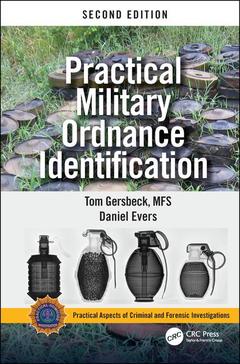Practical Military Ordnance Identification, Second Edition (2nd Ed.) Practical Aspects of Criminal and Forensic Investigations Series
Auteur : Gersbeck Thomas

The threat variables associated with military ordnance are enormous, requiring the application of a structured process to identify unknown munitions. The focus of Practical Military Ordnance Identification, Second Edition is the application of a practical deductive process to identify unknown ordnance items that are commonly recovered outside military control.
The author supplies a seven-step procedure to identify unknown munitions by their category, group, and type. Detailed logic trees help users narrow down the possibilities in order to accurately identify ordnance. The book covers the safety precautions associated with each category and group of ordnance. It describes many ordnance construction characteristics and explains the fundamentals of military ordnance fuzing. Appendices define terms and supply abbreviations and acronyms used to describe military ordnances.
Coverage new to this edition include: a list of conventional markings; additional safety precautions to take; an expanded list of high explosives; additional technical details on explosives effects; hazards associated with pyrotechnics, pyrophorics, smoke compounds, and incendiaries; a section on pre-1870 projectiles, hand grenades, landmines, underwater ordnances, and rockets; and details on Man-Portable-Air-Defense-Systems (MANPADS) missile systems.
1. Overview of Energetics Associated with Ordnance 2. Fundamentals of a Practical Process 3. Fuze Functioning 4. Projectiles 5. Grenades (Hand, Rifle & Projected) Chapter 6: Bombs & Aerial Dispensers 7. Rockets8. Guided Missiles 9.: Submunitions 10. Landmines 11. Chemical Ordnance 12. Underwater Ordnance Chapter 13: Black Powder Filled Ordnance Chapter 14: Closing List of Appendices Appendix A. Logic Trees Appendix B. Abbreviations Appendix C. Definitions of Ordnance Related Terms Appendix D. Explosives Appendix E. English – Metric Conversion Chart Appendix F. References
Tom Gersbeck served as an Explosive Ordnance Disposal (EOD) technician
in the U.S. Marine Corps, retiring in 2001 as a Chief Warrant Officer. He
then served seven years with the Federal Air Marshal Service (FAMS) as an
explosives security specialist before deploying as an independent contractor.
Deployments include two tours in Afghan CEXC facilities and one tour as
project manager of Task Force Paladin’s C-IED mobile training teams operating
throughout the country. Deployments supporting Department of State
as an EOD team lead in Iraq, advising the Tanzanian Peoples Defense Force
after the Gongo La Mboto disaster (Feb 2011) and training deminers with
Golden West Humanitarian Foundation in Cambodia.
Today, Tom is a full-time member of the graduate faculty for Oklahoma
State University’s School of Forensic Sciences, Arson-Explosives, Firearms
& Toolmarks Investigation (AEFTI) program. He holds a master of forensic
sciences (MFS) degree, is an active member of the International Association
of Bomb Technicians and Investigators (IABTI), is a Fellow in the American
Academy of Forensic Sciences (AAFS), and continues to work in his field.
Technical Researcher
Daniel Evers joined the Marine Corps in 2003 and currently serves as
an Explosive Ordnance Disposal (EOD) technician. While stationed in
California, North Carolina, and Japan, Daniel deployed to Iraq, Afghanistan,
Romania, Latvia, and Georgia in support of combat operations, responding
to IED and ordnance related calls for assistance, and training personnel
responsible for EOD-related work. However, Daniel’s advanced technical
ordnance knowledge and research abilities were developed during countless
inerting and disassembling operations on ordnance ranging from the mid-
1800s to the complex guided missile systems of today
Date de parution : 05-2019
15.6x23.4 cm
Date de parution : 05-2019
15.6x23.4 cm
Thèmes de Practical Military Ordnance Identification, Second Edition :
Mots-clés :
Fuzing System; General Safety Precautions; Explosives; Fuel Air Explosive; Propellants; Sketch Pad; Tri-Ethyl Aluminum; Aerial Bombs; High Explosive Main Charges; Dispensers; Author’s Photographs; Submunitions; Ordnance Categories; Rifle Grenade; Guided Missiles; Applicable Safety Precautions; Pyrotechnics; Riot Control Agents; Pyrophoric Materials; Incendiary Compounds; Explosive Main Charges; forensic science; Military Ordnance; investigation; Spotting Charge; bomb; Underwater Ordnance; Arms; General Identification Features; Munitions; Rotating Band; Explosion; Pe Crystal; Projectile; Time Fuze; Trinitrotoluene; Base Fuze; TNT; Black Powder; Missile; Brown Band; Minefield; Chemical Munitions; Power Cell; LE; Unexploded Ordnance; Arming Device; IED; Improvised Explosive Device; Booster; Cartridge; Demilitarization; Detonation; Detinator; Fuze; Warhead; Booby Trap; Blast Radius; Surface to Air Missile; Rocket; Grenade; MANPAD; Hand Grenade; Chemical Agents; Torpedoes


